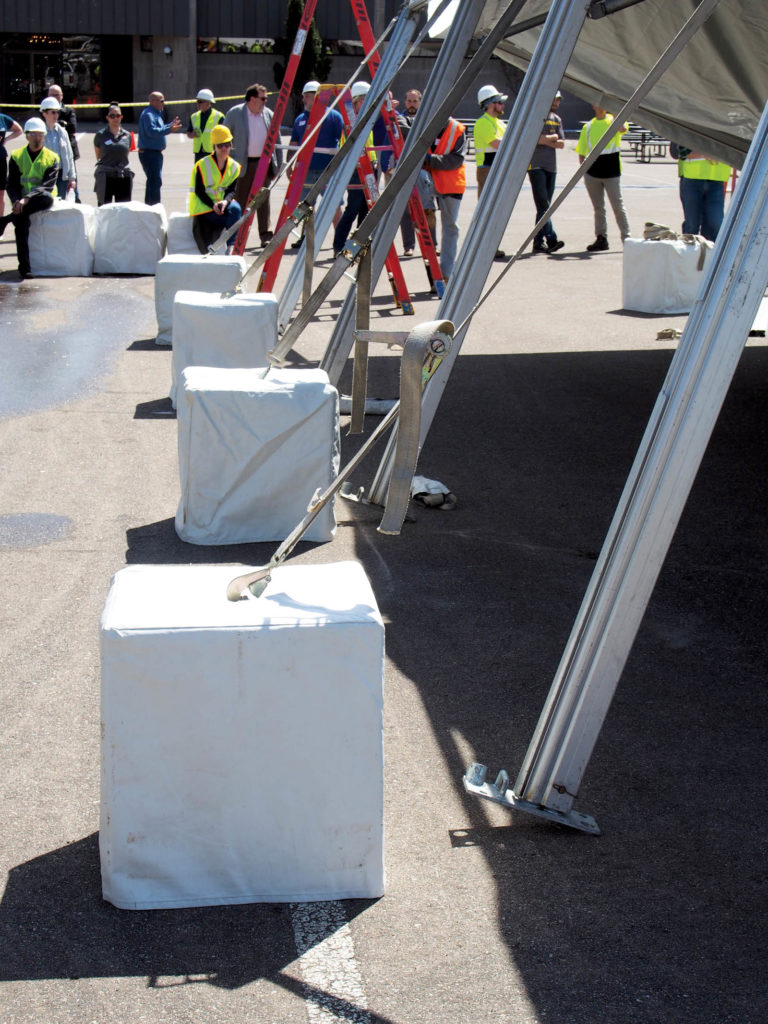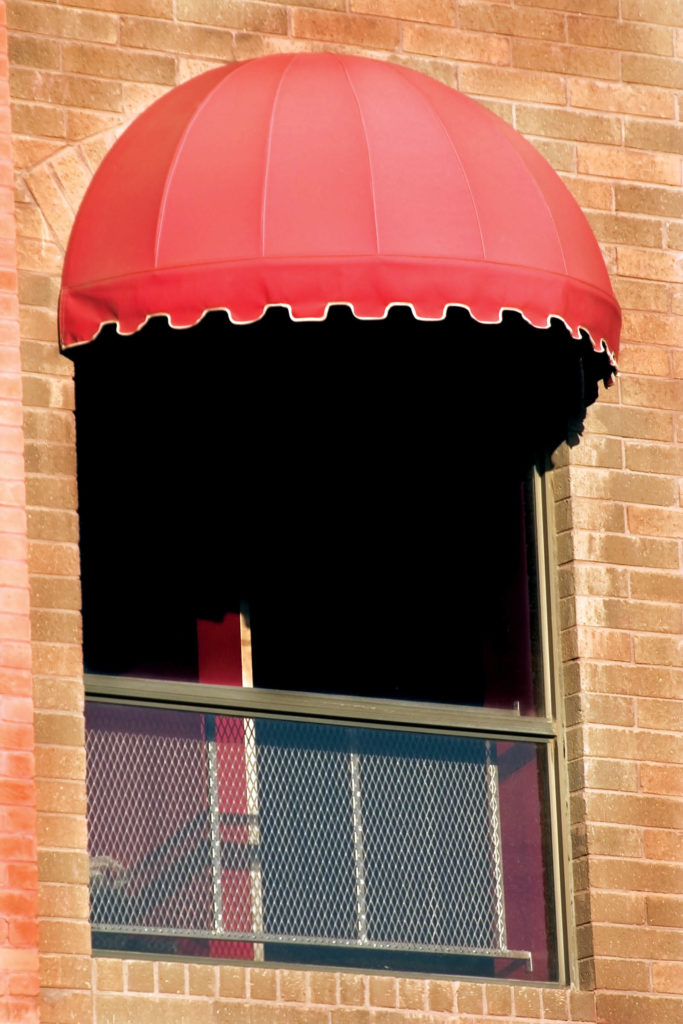
When tent, awning and fabric structure installers think of codes and standards, they often envision the building and fire departments of local and state jurisdictions that enforce such regulations on their projects. Enforcement is the very end of the process—the result of many years of code development work. The means by which such regulations are established and maintained is in many ways much more important, as it is very difficult to change these regulations after the fact. This article will give a simple overview of the change processes, describe how industry members can play a part in those processes, and offer an update on revisions in progress that affect the event tent, membrane structure and awning markets. It is important to begin with the basics.
Codes: These are the documents that, when adopted by an authority having jurisdiction, tell us when something is required. This can include fire-resistance rated assemblies/fabric, more substantial anchorage or even the maximum size of a given product.
Standards: These are referenced usually in the body of a code and detail how to do something such as how to conduct fire tests or how to design the anchorages. Standards specify the details needed for when codes require such testing, installation and so on.
U.S. building and fire codes
There are a few model code organizations in the United States that maintain and publish these codes. For members of the Industrial Fabrics Association International (IFAI), the two important organizations are the International Code Council (ICC) and the National Fire Protection Association (NFPA). The ICC is the predominant code organization that affects IFAI members. NFPA publishes the main standards that affect IFAI members. These organizations publish their codes every three years and have a process by which each code is updated or revised. The following are the main codes.
International Building Code® (IBC®): This is the ICC building code, and it is adopted by most jurisdictions in the U.S. It has four committees that hear all code change proposals. Typically, this code is enforced by the local building department. This code is mostly used for new and permanent projects.
International Fire Code® (IFC®): This code is enforced by the fire department or regional fire authority. There is one committee to hear the changes to this code. Consequently, it has quite a few to consider during its committee hearing. This code contains regulations to safeguard life and property from fires and explosion hazards, but it is also used for temporary projects such as event tents.
NFPA Building and Construction Safety Code® (NFPA 5000®) and Life Safety Code® (NFPA 101®): These two codes address projects similar to the IBC. However, they are not usually adopted by local cities and counties. Some states may adopt them, but the main governmental group that uses these codes is the U.S. federal government. If you have federal projects or federally funded projects, expect to use these codes.
NFPA Fire Code (NFPA 1):
This is the fire code for the NFPA. It is very similar to the IFC and is adopted by a few jurisdictions.

Standards
As noted earlier, standards tell us how to do something. This includes fire testing, load determination and spray application of flammable finishes. They are developed using an American National Standards Institute (ANSI) approved process and are usually published every six years. The following are a few standards that are important to IFAI members.
ASTM E84: This standard provides the test procedure for flame spread and smoke density indexes of surface materials. It is maintained by a standards development committee that continually meets to revise and update the standard.
ASCE 7 Minimum Design Loads for Buildings and Structures: This is a very big standard for determining the design loading of buildings and structures. The American Society of Civil Engineers (ASCE) has many committees that develop the criteria. The criteria range from wind and seismic loading to dead and live loads, with many other types of loads addressed within.
ASCE/SEI 55 Tensile Membrane Structures: This standard addresses the design, construction and installation of all types of membrane structures. It includes the former Air-Supported Structures Standard that I participated on in the 1990s.
There are thousands of additional standards under development for almost every type of industry. These standards are important, not only to level the playing field, but also from a liability standpoint.

Current proposals
Tents: With regard to IBC and IFC code development, there are a number of revisions in process now that address the following:
• The testing of tent fabric. IFAI is attempting to refer to the State of California regulations for the testing of tent fabrics. Unfortunately, this didn’t get a positive recommendation from the committee because the California State Fire Marshal is looking to revise the statutory requirements in the near future.
• The anchorage or ballasting of tents. A standing committee in the ICC has proposed to prohibit the use of water-filled vessels unless approved by the local fire marshal and in accordance with the tent manufacturer’s installation instructions. IFAI is looking to revise this to allow such ballasting when approved and in accordance with the tent manufacturer’s load specifications.
• The allowance of cooking within tents. The State of California has proposed to provide more definitive criteria for allowing cooking in or near tents. This is a correlation for the most part of other criteria in the IFC and is supposed to allow cooking in more circumstances.
In the ASCE 7 standards development process, a new subcommittee is proposed to review the applied loads for temporary special event structures, including tents. A study done by S. K. Ghosh Associates LLC (now a subsidiary of ICC) addresses the use of lower wind speeds for tents. This study has been sent to ASCE, and IFAI has requested to participate in the review subcommittee.
Membrane structures: A few proposals in the IBC/IFC code development process would affect membrane structures:
• Inflatable or portable enclosure prohibition for spray application processes. This proposal is intended to prohibit the use of such enclosures unless in compliance with NFPA 33. This is the standard for all spray application uses/processes. There is a revision requested in NFPA 33 to address inflatable or portable enclosures, so IFAI has requested that this proposal be revised to request compliance with NFPA 33 only without the initial prohibition. Codes are generally written in this manner, and IFAI is requesting support from the proponent of this proposal as well.
• New definition of Inflatable Amusement Device and referenced ASTM standard. New criteria are proposed in the IFC to address in more detail the use and testing of inflatable amusement devices. ASTM E2374-19 is proposed as the new standard. It is important to note that installations on private property are exempt from this regulation.
Awnings: IFAI submitted a proposal to the IBC similar to the tent proposal to refer to the State of California regulations for the testing of tent fabrics. This also didn’t get a positive recommendation from the committee because the California State Fire Marshal is looking to revise the statutory requirements in the near future.
IFAI also submitted a proposal to Appendix D Fire Districts in the ICC codes regarding the testing of canopy fabrics to eliminate the accelerated weathering and water leaching prior to the NFPA 701 tests being conducted. It has been brought to our attention that there are very few testing agencies that either can or will conduct such tests on large samples.
Your voice
This is only a small snapshot of the codes and standards activities that exist for IFAI and other industry associations to track. The voting membership of ICC is made up of building, fire and other governmental officials, and they need as much information as possible to be able to vote responsibly. If you are facing a code issue or would like to weigh in on a possible revision, please reach out to IFAI Division Operations Manager Christine Gerard at +1 651 225 6926 or cmgerard@ifai.com to have your voice heard.
Paul Armstrong, P.E., CBO, serves as IFAI’s code consultant. With more than 30 years of building safety management experience, he teaches regularly for California Building Officials (CALBO) and has developed several CALBO training courses. As a chief building official he managed building plan review, counter assistance and inspection for Southern California agencies. Additionally, he was responsible for development of new business for inspection and plan review services for jurisdictions across the United States. His previous experience at International Code Council (ICC) included leading the Architectural and Engineering Services Department and International Conference of Building Officials (ICBO) Technical Services Department.
SIDBAR: How can fabricators have an impact on code revisions and enforcement?
1. Get to know your local building and fire officials.
2. Attend local building and fire association chapter meetings.
3. Give educational presentations to local building and fire code officials.
4. Participate in state and local code adoption hearings.
 TEXTILES.ORG
TEXTILES.ORG


